Wharfinger (pronounced wor-fin-jer) is an archaic term for a person who is the keeper or owner of a wharf. The wharfinger takes custody of and is responsible for goods delivered to the wharf, typically has an office on the wharf or dock, and is responsible for day-to-day activities including slipways, keeping tide tables and resolving disputes.
The term is rarely used; today a wharfinger is usually called a "harbourmaster".
The word's etymology is probably Elizabethan-era English, [1] and possibly a corruption of wharfager. [2] An 1844 usage appears in Pigot's Directory of Dorset [3] in which Beales and Cox are noted to be wharfingers for the Port of Weymouth.
In Smith v. Burnett, 173 U.S. 430 (1899), the US Supreme Court set forth the primary duties a wharfinger owes to vessels using the dock. A wharfinger does not guarantee the safety of the vessels using its dock, but must exercise reasonable diligence to determine the condition of the berth, remove dangerous obstructions or provide a warning thereof, provide a usable entrance and exit to the dock, maintain sufficient depth for anticipated vessels by dredging, and warn of latent hazards and dangers. [4]
While the term "harbormaster" has supplanted the term "wharfinger" in some areas, it remains in popular use. For example, in the town of Saint Andrews in the Canadian province of New Brunswick, wharfinger is the name for the official responsible for the Market Wharf. [5] The same is true in the Port of Nanaimo in the Canadian province of British Columbia. [6] At the Port of Los Angeles, wharfingers are facilitators and problem solvers. [7]

A wharf, quay, or staith(e) is a structure on the shore of a harbour or on the bank of a river or canal where ships may dock to load and unload cargo or passengers. Such a structure includes one or more berths, and may also include piers, warehouses, or other facilities necessary for handling the ships. Wharves are often considered to be a series of docks at which boats are stationed.

A marina is a dock or basin with moorings and supplies for yachts and small boats. A marina differs from a port in that a marina does not handle large passenger ships or cargo from freighters.

Poole Harbour is a large natural harbour in Dorset, southern England, with the town of Poole on its shores. The harbour is a drowned valley (ria) formed at the end of the last ice age and is the estuary of several rivers, the largest being the Frome. The harbour has a long history of human settlement stretching to pre-Roman times. The harbour is extremely shallow, with one main dredged channel through the harbour, from the mouth to Holes Bay.

A dock is the area of water between or next to one or a group of human-made structures that are involved in the handling of boats or ships or such structures themselves. The exact meaning varies among different variants of the English language.
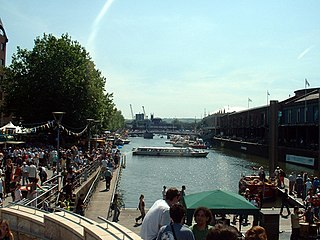
Bristol Harbour is the harbour in the city of Bristol, England. The harbour covers an area of 70 acres. It has existed since the 13th century but was developed into its current form in the early 19th century by installing lock gates on a tidal stretch of the River Avon in the centre of the city and providing a tidal by-pass for the river. It is often called the Floating Harbour as the water level remains constant and it is not affected by the state of the tide on the river.
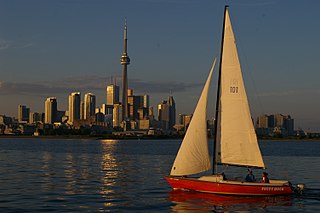
Toronto Harbour or Toronto Bay is a bay on the north shore of Lake Ontario, in Toronto, Ontario, Canada. It is a natural harbour, protected from Lake Ontario waves by the Toronto Islands. Today, the harbour is used primarily for recreational boating, including personal vessels and pleasure boats providing scenic or party cruises. Ferries travel from docks on the mainland to the Islands, and cargo ships deliver aggregates and raw sugar to industries located in the harbour. Historically, the harbour has been used for military vessels, passenger traffic and cargo traffic. Waterfront uses include residential, recreational, cultural, commercial and industrial sites.
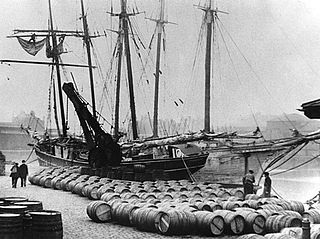
The Moorcock (1889) 14 PD 64 is a leading English contract law case which created an important test for identifying the main terms that the law will imply in commercial, or non-consumer, agreements, especially terms that are "necessary and obvious...to give business efficacy". Terms shall not be implied merely because they appear "desirable and reasonable". The case has been widely cited in later cases and is narrowly distinguished.

The Port of Karachi is one of South Asia's largest and busiest deep-water seaports, handling about 60% of the nation's cargo located in Karachi, Pakistan. It is located on the Karachi Harbour, between Kiamari, Manora, and Kakapir, and close to Karachi's main business district and several industrial areas. The geographic position of the port places it in close proximity to major shipping routes such as the Strait of Hormuz. The administration of the port is carried out by the Karachi Port Trust, which was established in 1857.

The Port of Hull is a port at the confluence of the River Hull and the Humber Estuary in Kingston upon Hull, in the East Riding of Yorkshire, England.

The Alma Doepel is a three-masted topsail schooner and is one of the oldest such ships surviving.

The Underfall Yard is a historic boatyard on Spike Island serving Bristol Harbour, the harbour in the city of Bristol, England.

The Port of Southampton is a passenger and cargo port in the central part of the south coast of England. The modern era in the history of the Port of Southampton began when the first dock was inaugurated in 1843. The port has been owned and operated by Associated British Ports since 1982, and is the busiest cruise terminal and second largest container port in the UK.

The Port of Lowestoft is a harbour in Lowestoft in the English county of Suffolk owned by Associated British Ports. It is the most easterly harbour in the United Kingdom and has direct sea access to the North Sea. The harbour is made up of two sections divided by a bascule bridge. The inner harbour is formed by Lake Lothing whilst the outer harbour is constructed from breakwaters.

Deptford Dockyard was an important naval dockyard and base at Deptford on the River Thames, in what is now the London Borough of Lewisham, operated by the Royal Navy from the sixteenth to the nineteenth centuries. It built and maintained warships for 350 years, and many significant events and ships have been associated with it.
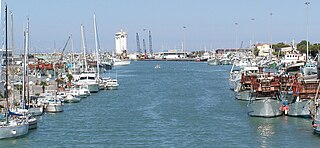
The port of Pescara is an Italian port on the Adriatic Sea at the mouth of the River Pescara in the city of Pescara. It is located at latitude 28.14 north and longitude 42 ° 14 ° 13 ', 78 East

The Grand Trunk Pacific dock was a shipping pier in Seattle, Washington. The original pier was built in 1910 and was destroyed in a fire in 1914. The pier was then rebuilt and continued in existence until 1964, when it was dismantled. The area where the pier stood is now part of the Seattle terminal of the Washington State Ferry system.
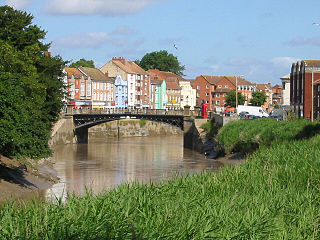
The Port of Bridgwater is a port, originally located in the town of Bridgwater, Somerset, England. Created under an 1845 Act of Parliament, it extends from Brean Down to Hinkley Point in Bridgwater Bay, and parts of the rivers Parrett, River Brue and River Axe. Although no ships now dock in the town, in 2001 103,613 (metric) tonnes of cargo were handled within the area of the Port Authority, most of which were stone products through the wharf at Dunball.

The Queensway Quay Marina is one of three marinas in the British Overseas Territory of Gibraltar, at the southern end of the Iberian Peninsula. The yachting facility is located at the eastern aspect of the middle section of Gibraltar Harbour. It is the site of what may be the oldest wharf in Gibraltar, Ragged Staff Wharf.
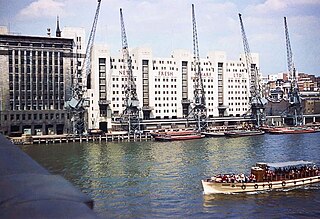
Fresh Wharf was a wharf located in the City of London close to London Bridge, on the north bank of the River Thames. The site was used as a quay in Roman times and later as an unloading place for Anglo-Saxon boats. A wharf was constructed there at some point in the medieval period and appears to have acquired its name from its customary usage as a landing place for fresh fish. In the 16th century, Fresh Wharf was made a "Legal Quay" authorised for the import of certain goods during the reign of Queen Elizabeth I of England. It expanded as London's river-borne trade grew in the 18th and 19th centuries, with large warehouses being established immediately behind the wharf. In the 20th century, the wharf's owners took over the adjoining wharves immediately upstream and downstream, built a new ten-storey warehouse and renamed the site New Fresh Wharf. By the end of the 1960s, however, London's docks had fallen into disuse with the advent of containerization, for which they were not suited, and the wharf was closed down in 1970. An office block was built on the site of the warehouse in 1977 and the former quayside is now part of a public footpath along the Thames.

Cockatoo Island Industrial Conservation Area is a heritage-listed protected area relating to the former Cockatoo Island Dockyard at Cockatoo Island, Sydney Harbour, New South Wales, Australia. It was added to the Australian Commonwealth Heritage List on 22 June 2004.